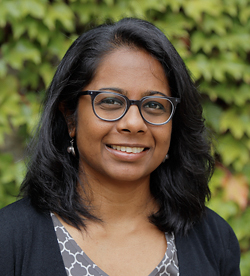Swetha Murthy, Ph.D.

Assistant Scientist, Vollum Institute
Email: murthysw@ohsu.edu
Phone: 503-494-4394
Office: Vollum 4419A
Biography
Swetha Murthy earned her B.S. from Bangalore University in India. She received her Ph.D. in Biochemistry from the State University of New York, Buffalo in 2012. Under the guidance of Gabriela Popescu she studied gating mechanism of NMDA receptors for her doctoral research. She trained as a postdoctoral fellow with Ardem Patapoutian at Scripps Research where she studied the functional and physiological characterization of mechanically activated ion channels. Murthy joined the Vollum Institute as assistant scientist in 2019.
Summary of current research
Touch or pain sensation, muscle contraction, and blood pressure regulation are just some biological processes that rely on the ability of cells and tissues to sense mechanical force. The process of converting mechanical stimuli into biological signals is called mechanotransduction and is mainly accomplished by mechanically activated (MA) ion channels and receptors. Impaired mechanotransduction can have severe consequences on mammalian physiology and can result in disorders such as loss of hearing, muscular dystrophies, and arteriosclerosis. Remarkably, the molecular underpinnings of many mechanotransduction-mediated processes and diseases are poorly understood, mainly because few bona-fide MA ion channels have been identified and characterized so far.
The overall research goal of the Murthy Lab is to define how MA ion channels detect and respond to physical stimuli, and understand how this response governs mammalian physiology. We recently identified the OSCA/TMEM63 family of proteins as MA ion channels that are conserved across plants and animals. Different isoforms within the family have distinct biophysical and gating properties, as well as disparate expression profiles in plants and animals. Therefore, molecular and physiological characterization of these ion channels can contribute to the current understanding of mechanotransduction.
Some questions that we are interested in are: How do these ion channels sense force? What is the physiological basis behind distinct gating and biophysical properties? How do they contribute to mammalian physiology? Our lab employs patch-clamp electrophysiology, calcium imaging, structural studies, and mouse genetics and behavior to address these questions. Furthermore, to continue to molecularly and physiologically define mechanotransduction, an overarching goal of the lab is to extend this workflow to identify and characterize novel MA ion channels.
Postdoctoral position available
A full-time postdoctoral fellow position is available in the Murthy Lab. Our lab focuses on the molecular and physiological basis of mechanotransduction — the process of converting mechanical stimuli into biological signals. Applicants with a background in neuroscience, biophysics, or cell and molecular biology, and expertise in patch-clamp electrophysiology, biochemistry, or mouse genetics are highly desirable; however, the lab is open to enthusiastic and motivated applicants keen to explore an unfamiliar field.
If you would like to join us please send a cover letter describing your past projects, scientific interests and career goals to murthysw@ohsu.edu. Please include your CV and the names, emails and phone numbers of three references.
Selected publications
* These authors contributed equally to this work
Syrenne JT, Sonawane PJ, Murthy SE. (2023) Molecular architecture of TMEM63 mechanosensitive ion channels. Cell Calcium. 115:102798.
Zheng W, Rawson S, Shen Z, Tamilselvan E, Smith HE, Halford J, Shen C, Murthy SE, Ulbrich MH, Sotomayor M, Fu TM, Holt JR. (2023) TMEM63 proteins function as monomeric high-threshold mechanosensitive ion channels. Neuron. 111(20):3195-3210.e7.
Murthy SE. (2023) Deciphering mechanically activated ion channels at the single-channel level in dorsal root ganglion neurons. J Gen Physiol. 155(6):e202213099.
Murthy SE. (2022) Glycine-bound NMDA receptors are stretch-activated. Trends Neurosci. 45(11):794-795.
Saotome K, Murthy SE, Kefauver JM, Whitwam T, Patapoutian A, Ward AB. (2022) Author Correction: Structure of the mechanically activated ion channel Piezo1. Nature. 607(7919):E10.
Xie Q, Li J, Li H, Udeshi ND, Svinkina T, Orlin D, Kohani S, Guajardo R, Mani DR, Xu C, Li T, Han S, Wei W, Shuster SA, Luginbuhl DJ, Quake SR, Murthy SE, Ting AY, Carr SA, Luo L. (2022) Transcription factor Acj6 controls dendrite targeting via a combinatorial cell-surface code. Neuron. 110(14):2299-2314.e8.
Jojoa-Cruz S, Saotome K, Tsui CCA, Lee WH, Sansom MSP, Murthy SE, Patapoutian A, Ward AB. (2022) Structural insights into the Venus flytrap mechanosensitive ion channel Flycatcher1. Nat Commun. 13(1):850.
Procko C*, Murthy SE*, Keenan WT, Mousavi SAR, Dabi T, Coombs A, Procko E, Baird L, Patapoutian A, Chory J. (2021) Stretch-activated ion channels identified in the touch-sensitive structures of carnivorous Droseraceae plants. eLife 10:e64250.
Murthy SE, Dubin AE, Whitwam T, Jojoa-Cruz S, Cahalan SM, Mousavi SAR, Ward AB, Patapoutian A. (2018 ) OSCA/TMEM63 are an evolutionarily conserved family of mechanically activated ion channels. eLife 7:e41844.
Jojoa-Cruz S*, Saotome K*, Murthy SE, Tsui CCA, Sansom MS, Patapoutian A, Ward AB. (2018) Cryo-EM structure of the mechanically activated ion channel OSCA1.2. Elife 7:e41845.